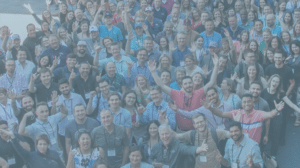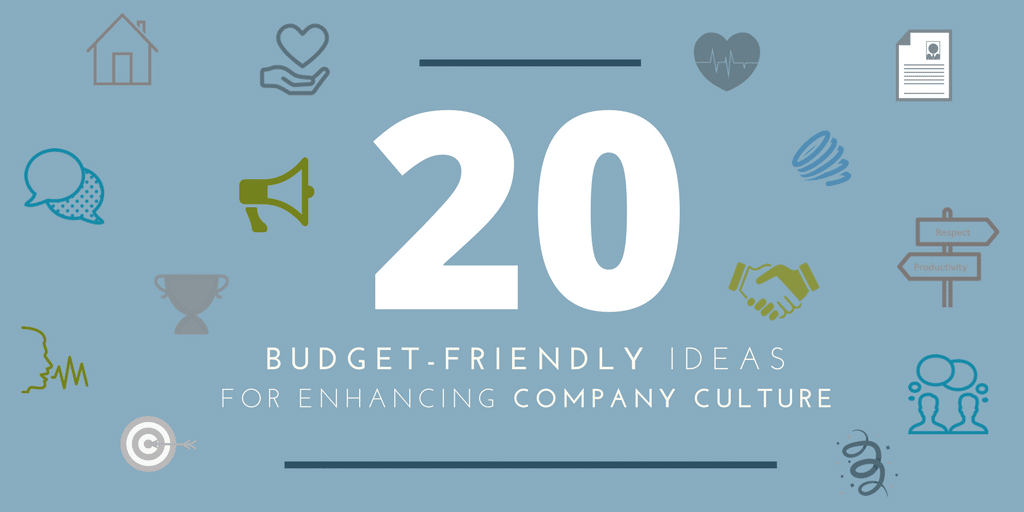20 Practical, Budget-Friendly Ideas to Enhance Company Culture
Many business owners focus their efforts on numbers – margin, profit, cash, overhead. While these things are important, they are far less important than we are led to believe. Leaders can get so caught up in data that they forget about the people who are the heart of their business. This is where corporate culture comes in. Growing and nurturing a positive culture can give companies a huge advantage over competitors. Positive, healthy company cultures place value on each employee in the organization regardless of job duties. This is important because it results in employees working together as a team to meet the company's and their own personal goals. Other benefits of strong culture are increased retention, overall satisfaction and promotion of your company as a great place to work and do business.
Of course, not all cultures are created equal. Big companies, with deep pockets, are able to offer much different experiences than small-to-midsized business. So how can you compete? How can you scale? At Stoneridge Software, we are growing – never before has maintaining and improving culture been so important! We are always looking for ways to enhance our culture and engage our team. It’s not always easy to know where to start, so here are 20 of our favorite practical, budget-friendly ideas to enhance company culture, that won’t break the bank and will strengthen the foundation of your business.
1. Purpose & Values
These components are free, and they are the most important when working to improve corporate culture. Stoneridge's values are Integrity, Technical Excellence, Tenacity, Client Centric, and Enjoy Our Work. These values are considered during hiring and in each decision we make. They define the beliefs of the company and give each team member purpose for the work they do.
2. Recognize Birthdays & Anniversaries
Recognizing an employee's birthday and work anniversary can be done through personal emails, handwritten cards, and lunches. This simple act of recognizing a special day demonstrates care for the employee, thus boosting motivation, morale, and productivity. This is also important as it is recognition separate from doing their job or a task well. The person will feel that they are important for more than just the work they do, but for the person, they are other than their job.
3. Flexibility
Stoneridge works to provide employees with the greatest amount of flexibility. Stoneridge CEO Eric Newell is a believer in the philosophy that there is no work/life balance, only life. Because of this, Stoneridge encourages employees to take time to coach, volunteer, read at your kids' school, make it to their games, and take advantage of unlimited vacation time. According to this article on advantages and disadvantages of flexible work schedules, flexibility has been shown to increase morale and engagement, reduce absenteeism and turnover, and recruit outstanding employees. Employees feel that their time is valued when they are given the opportunity to spend it how they feel is important.
4. Charitable Giving
Charitable giving provides many benefits for the organization that commits resources to it. Stoneridge's Pay It Forward program gives each employee $100 to contribute to an organization or cause of their choice. This communicates to them that the organization values their interests and what they care about matters. Since the creation of this program, Stoneridge has given over $8,000 to over 80 causes. For businesses, this program has another added benefit: providing networking and marketing opportunities while increasing the business' presence in the community. This creates a positive reputation for the organization and a segue for conversations that may turn into leads.
5. Family Leave
Another important investment in your employees is providing 100% paid family leave. At Stoneridge, maternity leave is 12 weeks paid and paternity and adoption leave are each 4 weeks paid. According to a resource on the science behind why paid parental leave is good for everyone, only about 12% of American companies offer paid parental leave. I disagree with the majority stating, "In my opinion, the support for parents shouldn't be a matter of luck; it should be a matter of course." Investing in the employee and their family is important to employees, and creates a loyalty in them for the organization. Employees who are paid during leave are much more likely to feel positive about their time away, thus motivating their return and incentivizing them to stay.
6. Collaboration Spaces
Collaboration spaces can take many forms including couches, tables, and chairs, and even as simple as an open office space. Working alongside people from different fields and backgrounds can bring a fresh perspective to your work. Your co-workers may be able to take a challenge you're stuck on and tackle it from another, unexpected angle. As the saying goes, the whole is greater than the sum of its parts. According to an article on workspaces that move people, workspaces that encourage collaboration reduce stress and depression, increasing their overall mood. In addition, employees are more energetic and working next to like-minded people can rekindle your drive and purpose. Creating "collisions" - those chance encounters between employees - improves overall performance.
7. Leaders Modeling Behavior
For many employees, relationships between managers and team members drive engagement and loyalty more effectively than Foosball machines, logo t-shirts, and Thirsty Thursday gatherings. While many employees leave an organization because of a bad manager, the opposite is true if good leadership and mutual respect is shown. Examples of this include telling the truth, communicating honestly about roles and responsibilities, being fair and open, and valuing real relationships. Stoneridge has great leaders modeling work-life harmony. Before joining the company I asked Stoneridge Software co-founders, Eric Newell and Becky Newell, how many events for their kids they've missed. Each answered confidently - none. This is the kind of balance our employees should strive for as well.
8. Employee Voice
Capturing employee voice for feedback and suggestions is an important way to reduce turnover and discover issues in a timely manner. There are free ways to do this through online survey tools or even the good old suggestion box. Stoneridge utilizes Officevibe, a confidential tool that asks each employee weekly questions via email and shares results anonymously with those designated. There are 120 science-based questions that measure 10 key metrics and 26 sub-metrics. This data is aggregated and presented so our organization has the data we need to take action and improve. This tool is $15 per user and includes an ROI calculator to understand how effective it is for your organization. While it's not important the way you collect this information, it is important that you do, in order to measure satisfaction and boost the team's morale.
9. Embrace The Social
As an organization, it is key to stop thinking that time spent not working or producing is a waste. According to an article on Social Productivity, we need to use our social time as another way of caring for ourselves. The concept of "Social Productivity" - how we spend our time being "social" - is different for everyone. For some, it might be large or small group settings and collaboration. For others, it might be one-on-one time in-person, building relationships and spending time together. Stoneridge embraces the social often through team lunches, which happen every first day for a new hire and every Thursday. Regular potlucks, holiday parties, and happy hours also help everyone get to know each other on a personal level. Additionally, we work on embracing the social with our clients through hosting Client Connects.
10. Meetings
It's true that most experts agree there are too many meetings and too much wasted time. While this is true, it's often because they are poorly planned and poorly executed. Stoneridge uses the book Traction and its Level 10 approach to run quality meetings that aren't wasted time. The objective of these meetings is to report on the status of the business, identify issues, discuss and solve them, and keep the team accountable for ongoing actions. These meetings have a consistent plan and they are concise to avoid disengagement. Team participation is ensured through segues given at the beginning of each meeting and ratings given at the end. The segues include questions about what they have done over the weekend, highs and lows, and what they're working on currently. The guideline at Stoneridge is if someone provides a rating for the meeting of seven or lower, they are asked to explain why and what could go better. It is every team members job to help ensure meetings are productive and a valuable use of time.
11. First Day Biographies
When most employers think of onboarding new employees, they typically first consider paperwork, introductions to the team, an office tour, and benefits. What is often overlooked is a plan that focuses on making the new employee feel welcome, appreciated, and part of the organization's culture as soon as possible. For Stoneridge, an important start to this plan is the first day biography sent via email company-wide. This offers an icebreaker and information that fellow employees can use to start a conversation with the new hire. The biographies are personal and include information on the person's family life, hobbies, and even their favorite shows on TV. Ours are lighthearted and include a photo so everyone in the company can recognize the new hire and reach out. This is a free and easy way to start a new hire on a positive and engaging note.
12. Lighthearted Recognition
KUDOS during meetings are an easy way to recognize the hard work your employees are doing for the organization. While recognition for work-related results is important, you might be missing another side of recognition that is just as effective. According to an article on the power of employee recognition, people who feel appreciated are more positive about themselves and their ability to contribute to the organization. These are often your best employees. Stoneridge has an annual "Stoney Awards" ceremony at our summer company meeting. Nominated by fellow team members, the "Stoney Awards" are fun, nonsensical, lighthearted, and are not performance-related. If you're a fan of The Office, think of the "Dundies." Some examples of past "Stoneys" are:
- Reverse Commuter Award
- Working the Remotest
- Grammar Police
- Most Likely to Leave a Whiteboard Dirty
Consider putting together an event or program that adds fun to the workplace. The only thing holding you back is creativity!
13. Wellness
Wellness programs have traditionally been viewed as a nice extra, not as a strategic imperative. However, new evidence tells a different story. According to a resource on the return on employee wellness programs, ". . . Organizations with highly effective wellness programs report significantly lower voluntary attrition than do those whose programs have low effectiveness (9% vs. 15%)." With tax incentives and grants available under the recent federal healthcare legislation, U.S. companies can use wellness programs to chip away at enormous healthcare costs, which are only rising with an aging workforce. Stoneridge has a wellness committee that identifies quarterly topics, communicates these initiatives, and plans quarterly wellness activities. Recent team outings include curling and and snowshoeing with social time after. In addition, Stoneridge provides standing workstations in the office and healthy food options at company events to promote overall wellness.
14. Trust
Companies can establish and build trust with little to no cost, and reap the rewards of more satisfied and fulfilled employees. According to an article on the connection between employee trust and financial performance, "Contrary to popular belief, cultivating a high-trust culture is not a 'soft' skill — it’s a hard necessity. Put another way, it’s the foundational element of high-performing organizations." The easiest way to build this trust is to follow-through on commitments and promises. Keeping your word is key for proving to your employees that you deserve their trust. Stoneridge has quarterly meetings to show trust in our employees through the sharing of information. They are informed of company cash flow, hiring projections, and key initiatives and strategies that are driving their work. Finally, employees are trusted to get their work done from anywhere, and many work from home a few days each week or are completely remote.
15. Feedback
Top performing companies are top performing because they consistently search for ways to make their best even better - not because they pay to use fancy systems or technology. Effective feedback, positive and negative, help establish ways both the company and individuals can be better. At Stoneridge, we have many points of contact to communicate feedback and better employees. The first ways are for new hires to give and receive feedback on their first month is through a 30-day Connect with me or a member of the human resources team. This time is spent talking about their onboarding experience as well as reviewing assessment results. Soon after, a 90-Day Review is completed by their direct manager with feedback from multiple sources that work with the person. This is similar to the 360 Degree Reviews that are done at the end of the year to provide comprehensive feedback from the previous year along with suggestions for improvement for the coming year. There are also regular 1:1s that direct managers have with their employees to have a casual conversation about what is and isn't going well. Finally, 4x4s are a form given to direct managers for their employees to fill out four questions four times each year, or quarterly. These four questions are:
- What's going well?
- What support do you need?
- Where do you want to go with your career?
- What could be going better?
The important thing with feedback is that it is consistent, honest, and goes both ways so each person is aware and able to make positive changes.
16. SWAG
SWAG is a slang term to describe the promotional products given away to employees as a form of advertising. These promotional products are branded with the company's name, logo, and/or colors. For new hires, this is a great way to welcome them to the organization and make them feel important. While there are costs associated with this, there are a vast amount of vendors and deals with items at every price point. The important part with SWAG is to ensure it is useful. These items are worn with pride to represent and create awareness of the company for new hiring opportunities or leads.
17. Free Beverages
When it comes to perks, few things are as simply satisfying as free drinks. According to a resource on the business trend of kitchen snacks for employee satisfaction, "Snacks and drinks can be the first thing prospective employees notice when they interview and the first thing they miss when they switch companies." Additionally, studies have shown that companies who provide free drinks have happier employees. Stoneridge stocks beverages like Vitamin Water, soft drinks, and even beer. The Keurig in the office is also well-equipped with a variety of coffee, teas, and hot chocolates. This can be made possible through delivery services or even a Costco membership. This small perk impacts each workday for your employees, and it won't go unnoticed.
18. Bonus Holidays
Not every company is able to afford unlimited time off, but time off from work to do your own thing is such a privilege. There are few people who don't want a little more of it, and bonus holidays every so often provide a more inexpensive way to give employees this perk. What a gift it is to be able to get personal things done, take a trip, or even just relax. Time off is worth more than money for a lot of employees and makes a great bonus for a job well done. One example would be giving employees their birthday off to celebrate how they wish. Bonus holidays for Stoneridge include early Fridays off during the summer as well as days off during the Holidays, for time to shop or spend with family.
19. No Dress Code
It's the 21st Century; in many situations, people wearing suits and formal attire to work is becoming a thing of the past. Mark Zuckerberg, the Founder of Facebook, can typically be found in a gray t-shirt and jeans. He has influenced the next generation of professionals' views of appropriate workplace dress. At Stoneridge, the philosophy is to keep it simple. Complexity breeds confusion. The dress guideline directly from our policy handbook is: "Dress comfortably and appropriately." Often the dress code is a reflection of the company's leaders, especially for small and medium-sized businesses. Ensure that your leaders model the appropriate dress. For a typical day in the office, you'll find most of our leaders and employees in jeans and a nice shirt. By giving your employees the autonomy to wear what they're most comfortable working in, you are valuing their opinion and preferences. You are also attracting similar employees that value this freedom as well.
20. Professional Development
Recent research conducted through LinkedIn found that the main way for employees to be productive and achieve goals is for employers to provide them with opportunities for continuous learning. This helps employees continue to improve their skills and be more flexible and adaptable, as changes in technology and other workplace matters arise quickly. When continuous learning is supported, employees feel valued, boosting employee engagement and retention. This support can also be given through managers helping their direct employees define career paths and establish goals. This identifies what the person needs to do for development and how the organization can help them in the process. Networking should always be encouraged for the employee's professional development, but additionally to improve and maintain the reputation of the organization.
Best wishes on your employee engagement and work culture mission. The hardest part is the first step, so if you’re reading this article you’re already off to a great start. If you have any creative ideas that have worked at your company we’d love to know!
Under the terms of this license, you are authorized to share and redistribute the content across various mediums, subject to adherence to the specified conditions: you must provide proper attribution to Stoneridge as the original creator in a manner that does not imply their endorsement of your use, the material is to be utilized solely for non-commercial purposes, and alterations, modifications, or derivative works based on the original material are strictly prohibited.
Responsibility rests with the licensee to ensure that their use of the material does not violate any other rights.





